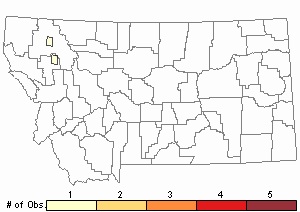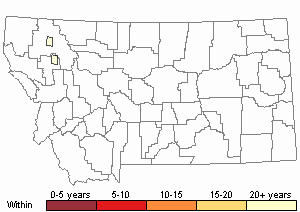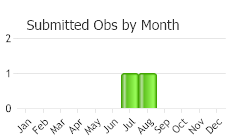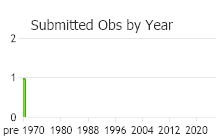View in other NatureServe Network Field Guides
NatureServe
Montana
Utah
Wyoming
Idaho
Wisconsin
British Columbia
South Carolina
Yukon
California
New York
Western Torncap Moss - Bucklandiella occidentalis
Other Names:
A Torncap Moss,
Racomitrium occidentale
General Description
Plants: Growing in open, upright clumps or turfs, olivaceous above, brown below. Stems upright, spreading to ca 45 degrees, or creeping, 2-4 cm, sometimes reaching 8 cm, few-branched; central strand not present (FNA 2007).
Leaves: Upright and flat against the stem when dry, spreading to ca 45 degrees when wet, 2.2-3.8 mm in length, 0.5-0.8 mm in width, a little bowed to straight; margins undulate, curved back and downward up to 3/4 the leaf length on both sides; costa reaching the apex, the dorsal surface strongly rounded and with a dorsal, slightly off-center, longitudinal channel interrupting the convexity; hair-pointed, the awns 0.3-0.8 mm in length, finely and sharply toothed, not decurrent, round in X-section (FNA 2007).
Leaf Cells: Costa in X-section with the boundary outline noticeably asymmetric, from 3-5 cell-layers thick proximally, transitioning to 2-3 layers above, with 2-5 dorsal cells proximally, transitioning to 2-3 above; margins of 2 cell layers above in 1 or 2 (occasionally more) rows, sometimes with patches having 3-4 cell layers; laminal cells 1-layered with lengths of 2-layers here and there, smooth; middle and upper cells square to oblong, frequently becoming wider than long at the leaf edges; basal laminal cells long and narrow, wavy, minutely knobbed, and with spiraled thickenings near the attachment; alar cells only a little modified (FNA 2007).
Diagnostic Characteristics
The asymmetric costa with its winged appearance in X-section is unique in the genus (FNA 2007).
Range Comments
Endemic to North America. BC s to CA (FNA 2007). Known in Montana from Flathead County (Elliott 2016).
Observations in Montana Natural Heritage Program Database
Number of Observations: 2
(Click on the following maps and charts to see full sized version)
Map Help and Descriptions
Relative Density

Recency



 (Observations spanning multiple months or years are excluded from time charts)
(Observations spanning multiple months or years are excluded from time charts)
Habitat
Dry to somewhat wet stones and bluffs; acidophile. Elevation: 0-5250 feet (FNA 2007).
Reproductive Characteristics
Seta 1-3 in a perichaetium, twisted clockwise above, 4-7 mm in length, somewhat ochre. Capsule 1-3 mm in length, a little creased when dry, shiny to dull brown; beak of operculum sometimes tilted; peristome dentitions papillose, lance-shaped, perforated or occasionally ruptured above into 2 lobes, brown (FNA 2007).
Stewardship Responsibility
References
- Literature Cited AboveLegend:
 View Online Publication
View Online Publication Elliott, J.C. and A.K. Pipp. 2018. A Checklist of Montana Mosses (1880-2018). Updated 3 January, 2020. Montana Natural Heritage Program, Helena, Montana. 73 pp.
Elliott, J.C. and A.K. Pipp. 2018. A Checklist of Montana Mosses (1880-2018). Updated 3 January, 2020. Montana Natural Heritage Program, Helena, Montana. 73 pp. Flora of North America Editorial Committee, eds. 2007. Flora of North America North of Mexico. Volume 27. Bryophytes: Mosses, Part 1. Oxford University Press, Inc., NY. xxi + 713 pp.
Flora of North America Editorial Committee, eds. 2007. Flora of North America North of Mexico. Volume 27. Bryophytes: Mosses, Part 1. Oxford University Press, Inc., NY. xxi + 713 pp.
- Additional ReferencesLegend:
 View Online Publication
View Online Publication
Do you know of a citation we're missing? Elliot, J. C. 1993. Second checklist of Montana mosses. Unpublished report. U.S. Forest Service, Region 1. Missoula, MT. 45 pp.
Elliot, J. C. 1993. Second checklist of Montana mosses. Unpublished report. U.S. Forest Service, Region 1. Missoula, MT. 45 pp. Lawton, E. 1971. Keys for the Identification of the Mosses on the Pacific Northwest. Reprinted from 'Moss Flora of the Pacific Northwest'. Published as Supplement No. 2 of the Journal of the Hattori Botanical Laboratory. Nichinan, Miyazaki, Japan. 66 pp.
Lawton, E. 1971. Keys for the Identification of the Mosses on the Pacific Northwest. Reprinted from 'Moss Flora of the Pacific Northwest'. Published as Supplement No. 2 of the Journal of the Hattori Botanical Laboratory. Nichinan, Miyazaki, Japan. 66 pp. Lawton, E. 1971. Moss Flora of the Pacific Northwest. Hattori Botanical Laboratory. Japan: Yamabuki-cho, Shinjuku-ku, Tokyo. 362 pages plus appendices.
Lawton, E. 1971. Moss Flora of the Pacific Northwest. Hattori Botanical Laboratory. Japan: Yamabuki-cho, Shinjuku-ku, Tokyo. 362 pages plus appendices. Malcolm, B., N. Malcolm, J. Shevock, and D. Norris. 2009. California Mosses. Nelson, New Zealand: Micro-Optics Press. 430 pp.
Malcolm, B., N. Malcolm, J. Shevock, and D. Norris. 2009. California Mosses. Nelson, New Zealand: Micro-Optics Press. 430 pp.
- Web Search Engines for Articles on "Western Torncap Moss"





